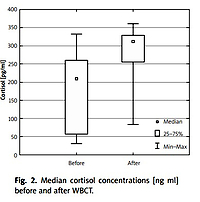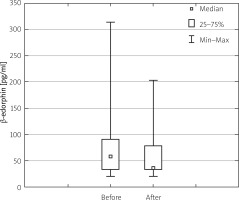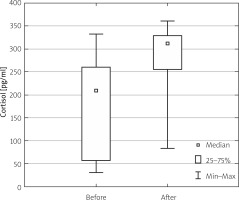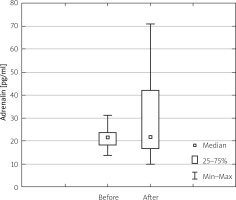Introduction
Experts estimate that 70% of the population after the age of 30 has suffered from low back pain (LBP), while after the age of 40, the incidence of these symptoms increases and affects 66% of men and 30% of women [1, 2]. One of the physical treatments for LBP, which has an effect on the secretion of many hormones, for example stress hormones and endogenous opioids, is whole body cryotherapy (WBCT) [3, 4].
Exposure to extremely low temperatures (–130°C) in the cryotherapeutic chamber is a strong stress; however, the biological effect of low temperatures on the human body is not yet fully understood [5–8]. Low temperatures cause hormonal changes; among others, they stimulate the pituitary axis and adrenal glands, and increase the plasma concentration of cortisol, as well as β-endorphins and catecholamines [9]. β-endorphin is one of the best known endogenous opioids, with strong analgesic properties. It is released into the blood under the influence of various factors, for example cold stress.
The aim of the study was to evaluate the impact of WBCT and exercises on LBP and plasma concentrations of β-endorphins, cortisol and adrenaline in patients with osteoarthritis (OA) of the lumbar spine.
Material and methods
The study group consisted of 30 patients (mean 59 ±8 years) with OA of the lumbar spine. Patients included in the present study based on the inclusion and exclusion criteria were selected from 80 rheumatology patients admitted for daily rehabilitation. Patients under 40 years of age, patients with acute lumbo-sacral radicular pain of the spine, and patients with other rheumatic diseases such as rheumatoid arthritis (RA) or ankylosing spondylitis (AS) were excluded from the study, as well as patients with individual contraindications to use WBCT or kinesitherapy.
The patients received a series of WBCT combined with therapeutic exercises. Patients underwent a series of 10 whole body cryotherapy procedures and a series of therapeutic exercises over a two-week period excluding the weekend. Patients with OA were qualified for the examination on the basis of a medical diagnosis, after taking into account the exclusion criteria and after excluding contraindications to this form of therapy. In addition, before each entrance to the cryogenic nitrogen chamber (–130°C), each patient’s blood pressure was measured. The duration of a single treatment in the cryochamber ranged from 1.5 to 3 minutes. After each treatment in the cryochamber, patients performed training for 45 minutes.
All patients performed the same set of exercises consisting of a warmup on a stationary bike or on a treadmill, general improvement exercises, and breathing and relaxation exercises. Therapeutic exercises were aimed at increasing the ranges of motion of the spine and peripheral joints, improving muscle strength, especially the abdominal muscles, back and upper and lower limbs, and improving the overall efficiency.
Before and after therapy, each patient was assessed on a visual analogue scale (VAS) and blood samples were collected. Plasma concentrations of β-endorphins, cortisol and adrenaline were determined using commercial assay kits (DLD Diagnostika GMBH, Adrenaline ELISA in plasma and urine EA604/96, Germany; DiaMetra Cortisol ELISA in human serum or plasma, DCM001-12, Italy; Wuhan Fine Biotech Co., Human βEP (Beta-endorphin) ELISA Kit β-EP (Beta-endorphin) in serum, plasma, tissue homogenates and other biological fluids, EH0696, China) by enzyme-linked immunosorbent assay (ELISA).
Statistical analysis
Statistical data analysis was performed using STATISTICA (StatSoft, Inc. 2020) (data analysis software system), version 13.1. The normality of the distribution of variables was checked using the Shapiro-Wilk test. The differences of the variables were verified with the Wilcoxon test. The p-value < 0.05 was adopted as the level of significance.
Results
Analysis of pain intensity using the VAS showed significant improvement after therapy in the study group. The decrease in LBP was statistically significant (p < 0.0001). As expected, WBCT combined with therapeutic exercises resulted in changes in plasma concentrations of β-endorphin, cortisol as well as of adrenalin. The distribution of the variables analyzed was not consistent with normal distribution.
The mean value of β-endorphin blood level increased from 51.2 pg/l before treatment to 55.8 pg/l at the end of therapy. The result was statistically insignificant (p = 0.1011; Fig. 1).
The mean value of plasma level of cortisol before treatment was 215.9 ng/ml, while the plasma level of this hormone after WBCT and exercises reached 275.8 ng/ml. The difference was statistically significant (p = 0.0009; Fig. 2).
The plasma level of adrenalin before treatment was 21.16 ng/ml and after the therapy increased to 29.9 ng/ml. The result was statistically insignificant (p = 0.1778; Fig. 3).
Discussion
Whole body cryotherapy combined with exercises is one of the physical treatments that stimulates the endocrine system, but the mechanism of cryotherapy is not fully understood [4, 20, 21].
Low back pain is the most common indication for the use of WBCT and kinesiotherapy. The results of our research show that WBCT combined with therapeutic exercises had a positive effect on LBP reduction in patients with OA (p < 0.0001). However, in assessing the effectiveness of physical treatments or therapeutic exercises, moderation should be maintained and the multitude of factors that may affect the occurrence of back pain in patients with OA should be taken into account. Whole body cryotherapy together with exercises reduces LBP and inflammation, and improves spinal mobility, muscle strength and endurance, which is confirmed by the results of research by other authors [2, 7, 19]. Whole body cryotherapy may influence the musculoskeletal system, cardiovascular, respiratory, excretory and endocrine system.
The hormones most frequently studied and described in relation to WBCT are the catecholamines adrenaline and noradrenaline, the endogenous opioids β-endorphins and the steroid hormone cortisol [4, 10, 15, 16]. β-endorphins are released into the blood under the influence of various factors, for example, nociceptive stimuli, stress, cold or during inflammation. Pain perception is modified at the level of the spinal cord, brain stem and subcortical centers. Pain impulses reaching the spine are inhibited by interneurons of the posterior horns of gelatinous substance. The main neurotransmitter of these structures is β-endorphin.
The results of our research indicate that exposure to cryogenic temperatures and cold stress slightly increases the release of β-endorphins in patients with LBP. Another factor causing stimulation of the endocrine system is extremely low temperature and the stress associated with it. Cold exposure activates the sympathetic nervous system and causes an increase in β-endorphin and noradrenaline release and increases synaptic release of noradrenaline in the brain [20, 21]. The synthesis of catecholamine occurs in adrenal medullary chromaffin cells, and release into the blood takes place in the process of exocytosis under the influence of the neurotransmitter acetylcholine. The release of catecholamines from the pheochromocytoma of the core occurs under the influence of many different stimuli, such as nervous stimulation, stress, hypothermia, some drugs or by stimulation of sympathetic fibers in the visceral nerves or by central nervous system impulsation [7, 11, 12, 13].
In our study, we followed up patients with OA but similar results were obtained after exposure to cryogenic temperatures of patients with RA. On the other hand, the results of studies conducted on a group of healthy women subjected to exercises in low-temperature water and a group of women undergoing systemic cryotherapy were slightly different. These studies showed a significant increase in noradrenaline plasma concentrations in both groups, but did not confirm an increase in adrenaline concentration [4].
In other studies, it was found that cold exposure causes in healthy men an increase in pituitary hormone LH levels with a simultaneous decrease in testosterone and noradrenaline [14]. The results of our research did not confirm this relationship completely. We observed a slight increase in adrenaline levels after the applied therapy but the difference was statistically insignificant.
An important hormone analyzed in patients undergoing WBCT is cortisol. Cortisol, belonging to the group of glucocorticoids, is produced in adrenocortical cells, and its average level in the blood plasma ranges from 50 to 150 μg/l. The concentration of this hormone in the blood increases during stressful situations, stimulates the processes of gluconeogenesis and reduces the rate of glucose utilization by skeletal muscles during physical exertion [15, 16]. Based on our research, we observed that after the applied cryotherapy, the concentration of cortisol increased significantly (p = 0.0009).
However, the results of other authors’ research are inconclusive. Studies carried out in groups of women treated with whole body cryotherapy at a temperature of –110°C and cold baths at a temperature of 0 to 2°C showed a significant reduction in secretion of cortisol after applying these procedures [4].
On the basis of studies conducted on a group of canoeists who underwent WBCT it was observed that the concentration of cortisol increased after the applied therapy [17]. These results are consistent with our own observations. The results of other studies indicate that regular post-exercise WBCT applied during a 4-week high-intensity interval cycling training program had no advantageous effect on basal catecholamine and cortisol concentrations [18, 19].
Conclusions
Catecholamine adaptations to exercise and WBCT are still unclear. The hormonal reactions after WBCT may also be different in terms of plasma catecholamine concentration depending on whether physical exercises were performed before or after the procedure. Concentrations of catecholamines may be elevated after endurance and sprint training as compared with untrained individuals; these concentrations typically do not change following a period of regular training. It can be assumed that different training forms and levels of cold exposure also lead to different hormonal adaptations.
Whole body cryotherapy procedures stimulate the nervous system and, as a result, increase the release of analgesic β-endorphins. This is probably the body’s response to cold and the stress related to it.
Despite the fact that the mechanism of action of extremely low temperatures on the human body is still not fully understood, this procedure is used in the biological regeneration of athletes and in the rehabilitation of patients with LBP.






